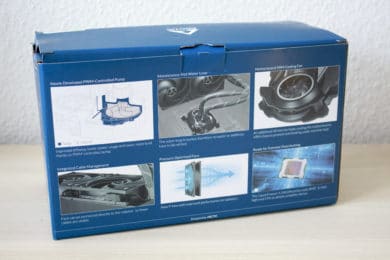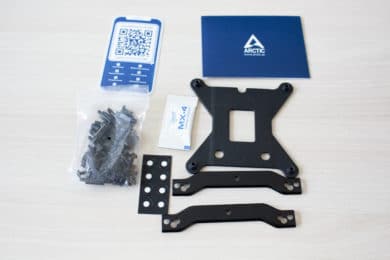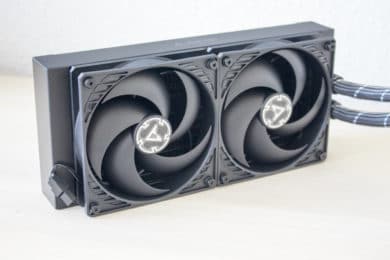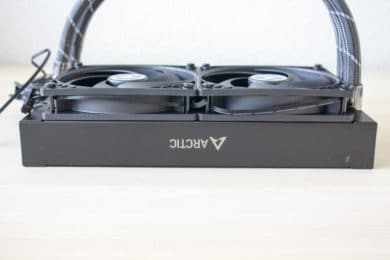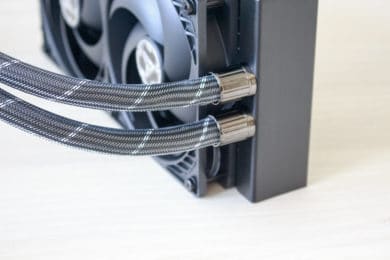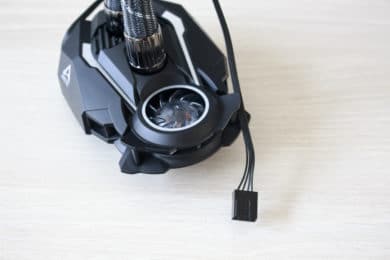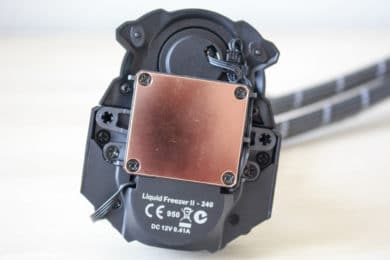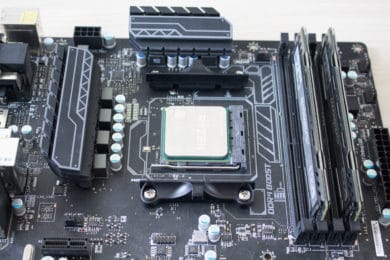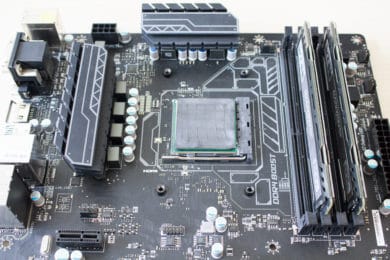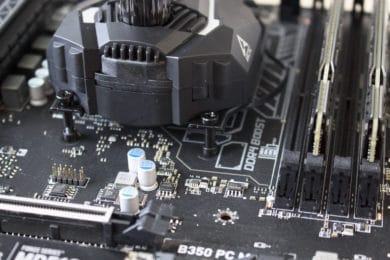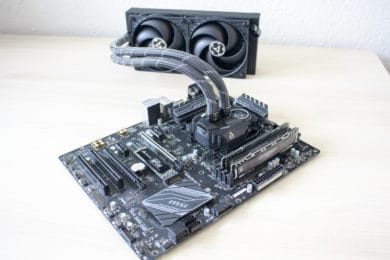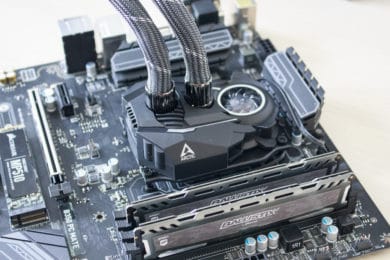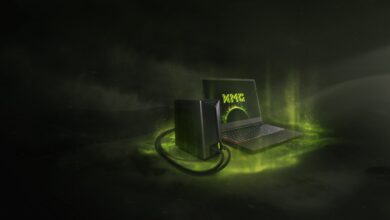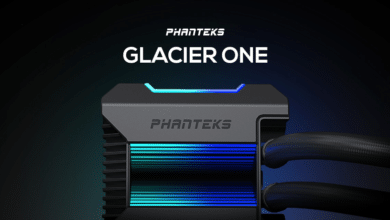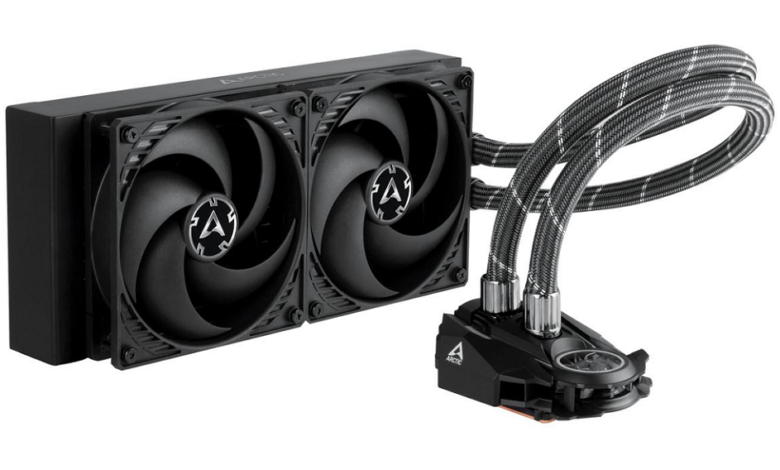
The manufacturer Arctic has long been a very well-known manufacturer of CPU coolers, GPU coolers and case fans. Especially the CPU coolers of the Freezer series and GPU coolers of the Accelero series have made this brand famous worldwide. About four years ago another product was added to the already quite diversified portfolio. This was an all-in-one water cooling system called Liquid Freezer. In addition to the double or quadruple configuration with fans, the Liquid Freezer has attracted attention mainly due to its low price and has won many price-performance awards.
In October 2019 Arctic has now introduced the successor. This AiO goes by the simple name of Arctic Liquid Freezer II and comes in the radiator sizes 120 mm, 240 mm, 280 mm and 360 mm. Like its predecessor, this compact water cooling system is expected to convince with good performance and an attractive price. In this review you can read how the € 114.68 * expensive Arctic Liquid Freezer II 240 performed in our test parkour.
Technical details
Cooler specifications
| Dimensions (with fan) | 277 x 120 x 63 mm (W x H x D) |
| Weight (with fan) | 1.19kg |
| Material | copper (radiator bottom), aluminium (fins) |
| Supported cooling capacity |
300W TDP |
| Compatibility AMD | AM4 |
| Compatibility Intel | 115x, 2011, 2011-3 (Square-ILM), 2066 (Square-ILM) |
| Price | € 114.68 * |
| Special features |
pump with VRM cooling |
fan specifications
| Fan designation | Arctic P12 PWM |
| Dimensions | 120 mm x 120 mm x 25 mm |
| Weight | 144 g |
| Speed | 200 – 1800 rpm |
| Volume | 0.3 Sone [Max.] |
| Flow volume | 95.7 m³/h |
| Air pressure | 2.2 mm H2O |
| Special features | Fluid Dynamic Bearing |
Pump specifications
| Dimensions | 98 mm x 78 mm x 53 mm |
| VRM fan | 40 mm, 1000 – 3000 RPM (PWM controlled) |
| Pump | 800 – 2000 RPM (PWM controlled) |
| Base plate | copper |
| Tube length | 450 mm |
| Hose diameter | Outside: 12.4 mm Inside: 6.0 mm |
| Special features | VRM fan |
Packaging & delivery scope
The Liquid Freezer II 240 comes in an amazingly compact cardboard box. It is printed in color and contains all technical information and a list of key features of this compact water cooling system. All information is written in English.
If you unpack the contents of the carton, you will find the AiO incl. pre-assembled fan, a bag with all mounting accessories (screws, backplate, spacers, brackets, thermal compound), a warranty brochure and a QR code for the mounting instructions. To protect the radiator, pump and fans from any damage, all components are wrapped in foil and cardboard.
Design & Workmanship
Optically, the Arctic Liquid Freezer II 240 is kept simple and the manufacturer does without all RGB effects or digital displays in favor of a lower price. The aluminium radiator is painted completely black and 38 millimetres thick. Since this thickness is often slightly lower than that of the competition, the Liquid Freezer II could achieve better temperatures. However, the additional thickness also increases the likelihood of compatibility problems in some cases.
Arctic has attached two sleeved water hoses to the radiator with two silver fasteners. The hoses are 450 millimetres long and are discreetly designed in grey and white. At the other end of the hoses is of course the pump block. The pump installed in it rotates at a maximum of 2000 revolutions per minute and has a copper base plate. The pump cover is made of plastic and does not have a digital display or RGB lighting. But there is a fan for cooling the voltage converters on the mainboard. The fan has a diameter of 40 millimeters and rotates with a maximum of 3000 revolutions per minute.
The two included fans of the Arctic P120 PWM series are completely black and optimized for high air pressure. Both fans have a 4-pin PWM connector and rotate at a maximum of 1800 rpm. To avoid cable clutter, both are directly connected to the pump’s PWM connector and do not need to be connected separately. The cables disappear directly between the sleeve and the water hose. This saves cable management when installing the AiO in a housing and all moving parts of the AiO (3x fan, 1x pump) can be controlled via a single PWM connection.
Mounting
For the review, a test system on a benchtable is used. This allows us to exclude disturbing factors such as heat accumulation in the housing. The test system consists of the following components.
- AMD Ryzen 7 2700X @ 3.8 Ghz at 1.3V
- MSI B350 PC Mate
- Crucial Ballistix Sport LT grey 16 GB DDR4-2666
- Plextor PX-256M8 NVMe SSD
- Gigabyte AORUS GTX 1060 6G
- Thermaltake Berlin Pro RGB 650W
- Cooler Master Tech Bench V2.0
As already mentioned, there are no installation instructions in the scope of delivery. It can only be opened by calling up a QR code. This code links directly to the manufacturer’s homepage and is available in a total of eight languages. In addition to a clear arrangement of the assembly steps, a complete assembly video is always included.
The assembly of the AiO water cooling system in our test system with AM4 socket required only a few parts and was quickly completed. First the radiator including the fans has to be connected to the housing. This step is omitted in this case due to the use of a bench table. Then the pump has to be prepared for mounting. For this purpose, it is provided with two retaining brackets on the underside. Then the upper plastic brackets of the AMD retention module must be removed. The backplate of the retention module remains behind the mainboard.
The Carbonaut heat-conducting pad from Thermal Grizzly is used as the heat-conducting paste due to its easy handling. After placing the pad on the heatspreader, the pump is placed on the base and connected directly to the backplate of the mainboard with four screws.
The assembly of the cooler was quickly completed and the animated instructions on the homepage were clear and unambiguous. Although the assembly system is simple in design, it looks solid and serves its purpose. However, there is no adjustment of the contact pressure via spring-mounted nuts. Instead, the backplate for Intel sockets is made of solid metal and looks stable.
volume and cooling capacity
As already shown in the previous chapter, we use an AM4 system based on the Ryzen 7 2700X and the MSI B350 PC Mate as test hardware. The Ryzen runs on 3.8 GHz at 1.3 volts.
To heat up the processor, the processor was loaded with Prime95 for 15 minutes. The CPU temperature was then read out with the CPUID hardware monitor. This test was performed in two different scenarios. The values were then compared to those of the AMD Boxed Cooler (Wraith Prism RGB) and the recently tested Arctic Freezer 34 eSports DUO. During the temperature measurements the room had a temperature of 18°C.
| cooler | operation scenario | RPM | temperature |
|---|---|---|---|
| AMD Wraith Prism RGB | 50% PWM | 1600 rpm | 92 °C (fan turns up to 100%) |
| AMD Wraith Prism RGB | 100% PWM | 3000 rpm | 75 °C |
| Arctic Freezer 34 eSports DUO | 50% PWM | 1250 rpm | 69 °C |
| Arctic Freezer 34 eSports DUO | 100% PWM | 2100 rpm | 63 °C |
| Arctic Liquid Freezer II 240 | 50% PWM | 1000 rpm | 64 °C |
| Arctic Liquid Freezer II 240 | 100% PWM | 1800 rpm | 60 °C |
As expected, the Freezer 34 eSports DUO performs significantly better than the boxed cooler. It is also not surprising that the Liquid Freezer II 240 achieves even better temperatures. On top of that, the all-in-one water cooling doesn’t reach a particularly high volume even at 100%. Even the small VRM fan is unexpectedly quiet. Only the pump emits a subtle whirring sound. This can only be heard if you hold your ear close to the pump.
With the performance shown, this compact water cooling system is also suitable for more powerful CPUs such as a Ryzen 9 3950X or i9-9900K. Due to the VRM cooler, this AiO also prevents the voltage converters from overheating. Depending on the motherboard and the mounting position of the radiator, this can be a problem with many compact water cooling systems.
Conclusion on Arctic Liquid Freezer II 240
With the Arctic Liquid Freezer II 240, the Swiss manufacturer has done it again. By dispensing with RGB, the use of a fan for VRM cooling and a thicker radiator, this compact water cooler cuts a fine figure even with overclocking. The overall cooling performance is good and all components can be described as quiet. Also the workmanship of the compact water cooling is good.
What has to be differentiated is the connection or control of all components via a single 4-pin connector. On the one hand, this eliminates the need for complex cable management and simplifies the connection. On the other hand, some buyers would probably wish to be able to control the fans independently of the pump. In addition, Arctic unfortunately had to cut back on the mounting system and the scope of delivery due to the price. Both are useful, but nothing special.
If performance and price are finally taken into account, the Arctic Freezer II 240 is a recommendable AiO water-cooling system for all those who only value cooling performance and can do without RGB lighting.
Arctic Liquid Freezer II 240
Design
Workmanship
Mounting
Cooling
Value for money
90/100
Inexpensive compact water cooling with focus on the essentials: performance and low noise.



